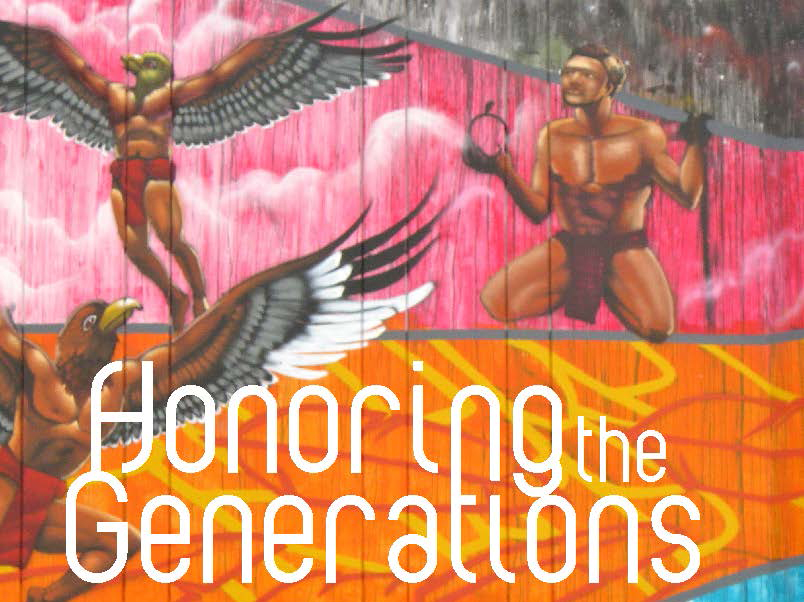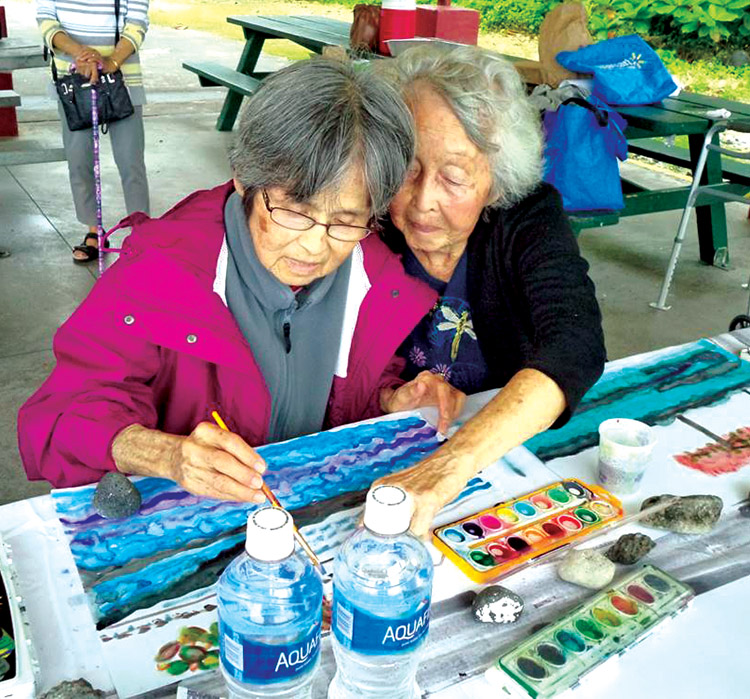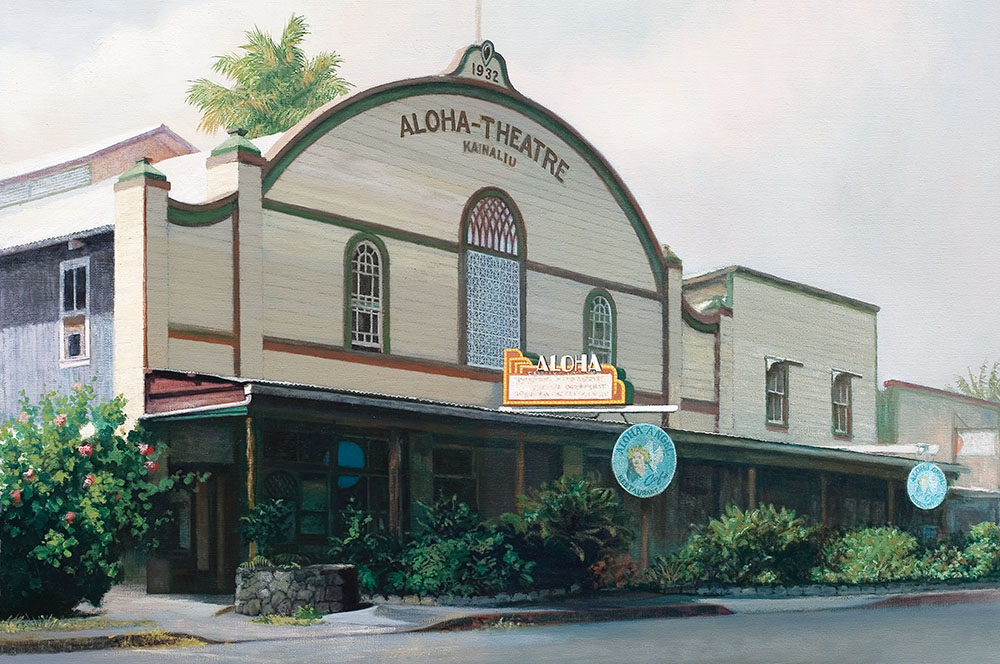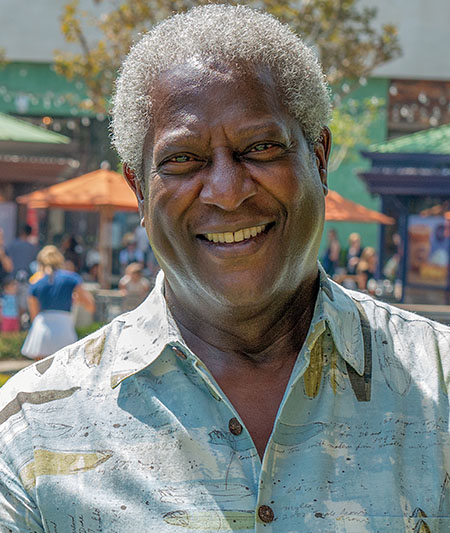
Honoring the Generations
Lāna‘i mural pays tribute to the past and to the future
 The mural is astonishingly beautiful. Born as an idea in the mind of middle school math teacher Michelle Fujie, creating Ke Ali‘i Ka ‘Āina—The Land Is Chief seemed an impossible task. Yet through the vision and cooperative effort of many, this impossible task was completed in two-and-a-half months.
The mural is astonishingly beautiful. Born as an idea in the mind of middle school math teacher Michelle Fujie, creating Ke Ali‘i Ka ‘Āina—The Land Is Chief seemed an impossible task. Yet through the vision and cooperative effort of many, this impossible task was completed in two-and-a-half months.
From the sophistication of graffiti artists working with O‘ahu’s 808Urban, to the nuts-and-bolts organizing effort of Michelle, her students and community volunteers, a huge blank wall on the north side of the Lāna‘i High and Elementary School gym has been transformed into a brilliant depiction of the history of the island—its myths, stories, heroes and real people.
Arching through the colors of the rainbow from east to west, from dawn to dusk, the mural begins with the unassuming petroglyph of a small dog, reaching into the sky with the flying figures of the island’s legendary bird men, touching the heavens, where the constellation of the whale is accompanied by a humpback whale and a diver. It travels through a field of symbolic pineapple crowns, to the hope for the future, as symbolized by a glowing “cosmic” butterfly in the hands of a young girl.
Michelle first thought of having her students paint a 9-by-12-foot mural on her middle school math classroom as a tribute to the memory of her beloved grandmother, Helen Fujie. Paging through her scrapbook devoted to her grandmother’s accomplishments, Michelle remembered Helen’s lifelong devotion to the arts, and realized that a mural would be both a fitting tribute to her grandmother and a way that her seniors could leave their impression on the school.
However, from an idea to a finished work is a long and difficult journey—in this case, marred by missed shipments of paint, heavy rain that turned the turf at the base of the wall into slushy mud that could not support the lift, and ongoing confusion as to what exactly the mural would look like.
Michele took her students to wahi pana (sacred places) accompanied by stories and remembered names. Sometimes the weather wouldn’t let them follow their original destination, so they changed directions. From one day came the inspiration to include petroglyphs, and the memory of the sharp wind and wild grasses at Pōʻaīwa.
They turned southwest and followed the rocky, bumpy trail down into Kaunolū and its heiau and more petroglyphs, foaming tide pools and transparent water. While they traveled, they learned the stories about those places and began to find a connection to their island. It was not only art that was involved; it was becoming ma‘a (knowing thoroughly) to that place. They drew pictures of things that were interesting—fish, diving, eating by sea in the moonlight, baskets of fish and taro; their sustenance.
The mural slowly unfolded in the minds of everyone who thought about it, and began to take shape on paper.
This was not merely a dreamscape—a way to envision a work of art that would tell the story of their island—it was material. Paint, brushes, containers, safety equipment and ladders had to be bought, picked up, carried, stacked. Equipment had to be found; volunteers gathered to paint and help. A whole complex of actions and motions—get the paint from the harbor, make sure about the lift, check the weather, pick up the artists from O‘ahu, copy the release forms.
Early on, Michelle had called John “Prime” Hina from 808Urban, an O‘ahu neighbor-centered arts organization of “graffiti” artists who had taken their outlaw art and tamed it in murals around the city.
The urge to leave your mark is strong in humans. There are correlations between spray-can graffiti and petroglyphs—each made by someone passing by who wishes to leave the memory of their travels behind. For centuries, it was boulders and rock walls—now it is freeway underpasses.
But graffiti is rejected as a form of art, so these artists of spray-can and large vision had formed 808Urban, with a mission to catalyze and assist neighborhoods in creating their own murals and delving yet deeper into their local history, rather than leaving a simple signature sprawled across a wall.
Michelle told Prime her story—her ambition to paint a mural on her classroom wall as a tribute to the memory of her grandmother, Helen. She had no money, but sent $50 as a donation. She also sent a photo of her classroom, and looming behind it was the blank wall of the gym.
“What’s that wall?” asked Prime.
In that instant, the project took a lurch and shifted into what was accomplished some 10 weeks later—a 3,000-square-foot mural glorifying the island’s history and welcoming its future.
Michelle’s middle school math students measured the wall, using the skills they learned. Sketches of ideas to include in the finished painting were pinned to the classroom walls, and students and volunteers held workshops to explore the concepts and places that would be illustrated.
Their ideas were given to Wendell Kaho‘ohalahala, an island artist, to combine in a master sketch, which was then projected full-size onto the wall and dots painted to define the lines in the drawing—a process not so different from the one that Michelangelo used when painting the Sistine Ceiling. Michelangelo had the support of the church; the Lāna‘i mural had the support of almost everyone in the community, and its progress became a daily event of interest as this crazy, impossible project took form.
Crises occurred. The weather was not helpful, heavy rain turned the ground under the wall soft and unreliable. The lift got mired in the mud; had to be hauled out; the ground could not support its weight.
There was a tight schedule because the painting had to be finished by January 10. There was only a one-week winter break when the students would be free to paint and help. The artists from O‘ahu had to be supported, transported, fed, welcomed and housed. People got to know one another, worked together, friendships formed, knowledge was transferred and the beauty of the island experienced.
When Prime talks about the mural, he talks about Lāna‘i and what it meant for him to come here from O‘ahu.
“Lāna‘i,” he said, “where people wave at one another and know your name, something long gone out of the life on O‘ahu. Working on the mural gave us the chance to know the stories; but not only the stories, the places, and to also know each other. It was interesting, just how much the students know and how much they didn’t know.”
For many young people on Lāna‘i, buried in their iPhones and preoccupations, the island is a background to daily life devoted to a repetitions routine. Flying birdmen and even the rattle and roar of pineapple trucks down at Kaumālapaʻu are as remote as the moon. The moon, too, is rarely noticed in their daily lives, but she centers the mural and her rays extend to the horizon. Getting ma‘a (familiar) to not only places on Lāna‘i, but also the actual heavens, was certainly a learning experience.
It was messy, it was fun, it was scary and it took concentration and focus. Kids painted light blue waves for hours, tending paintbrushes, keeping them clean. There were conversations at the wall while working, and some places a deep silence reigned, marred only by the sound of a passing truck or plane. Something happens when one paints—mind comes together with eye and is absorbed. It’s calming, and the atmosphere around the wall when people were working was quiet and settled.
Very slowly, the colors emerged and the vision took form. Here is Maunalei, the valley where taro flourished, the place of the year-round stream flowing to the sea to nourish the reef that sheltered small fish floating in the surge. Maunalei is crowned by the moon, with rays extended into the colors of the rainbow. In the east with the sunrise, men with the perfect wings of great birds soar into the sky. Above them is Kaululā‘au, who drove the spirits off the island and made the land safe for settlement. He holds an ʻulu, a breadfruit, a generator of growth, of food, of life.
The whales are with him, the one in the sky that guides the navigators, and the one of flesh that brightens the deep with his breaching. A diver is there, and as the rainbow arcs to the west in the orange and yellow of the setting sun, two kids ride their bikes in the pineapple fields. A family is sitting on the beach in the moonlight. There is a fire and food cooking; and it will soon be time to sleep.
Then to the west, larger than any of the mythic, historic people, is a young girl wearing a pink shirt. She is looking down at her hands holding a brilliant purple and green butterfly. The girl completes the symbolism, from the inspiration of the grandmother, through the granddaughter, to the great granddaughter, the lineage continues. Life is born and reborn, and there will be time for other stories and other heroes and new legends.
How the mural evolved, and what it finally came to be is the work of many, many hands. Each gave what they had to give, and each can look up at the big wall of the Pedro de la Cruz Lāna‘i High and Elementary gym and be proud.


